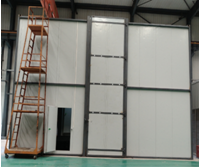Testing equipment for curtain wall doors

1. National standard
GB/T 29043-2012 "Classification and Testing Method of Thermal Insulation Performance of Building Curtain Walls"
GB/T 8484-2020 "Classification and Testing Method of Thermal Insulation Performance of Building External Doors and Windows"
2, American standard (optional)
AAMA 507-12 Standard Specification for Determining Thermal Performance Characteristics of Window and Door Systems in Commercial Buildings
AAMA 1503-09 "Accredited Test Method for Thermal Conductivity and Dew Resistance of Doors, Windows and Glass Walls"
3, European standard (optional)
BS EN ISO 12631-2012 "Calculation of the transfer coefficient of thermal performance of curtain walls"
BS EN ISO 12567-1:2010 "Thermal performance of doors and windows - Determination of heat transfer coefficients by the hot box method - Part 1: Entire windows and entire doors"
ISO 8990-1994 "adiabatic - steady state heat transfer properties of the determination - calibration and protective heat box method"
【Technical parameters and features】
Building curtain wall insulation performance testing equipment, based on the principle of stable heat transfer by the calibration of the heat box method. One side of the specimen is a heat box, simulating the heating building winter indoor climate conditions, the other side is a cold box, simulating the winter outdoor climate conditions. In the specimen of the gap sealing treatment, both sides of the specimen to maintain stable air temperature, airflow velocity and thermal radiation conditions, by measuring the heating power of electric heater, calculate the heat transfer coefficient of the unit area of the specimen under the set temperature difference K, unit: watts/(square meters * degrees). At the same time, in the stable heat transfer state, measure the average temperature of the air in the cold and hot chamber and the temperature of the specimen profile or the hot side of the glass, and calculate the anti dew factor of the specimen. The testing equipment should be composed of cold chamber, hot chamber, specimen frame, environmental space, heating and refrigeration equipment, control system and so on.
1.1. Overall
1. External dimensions of equipment insulation box: width 4600×height 5730×length 6500mm
2. Matching drive: AC 380V, power 60KW
3. Temperature sensor Pt1000 platinum resistance class A, accuracy: ≤0.02°C
4. Test mode: automatic detection mode and manual detection mode
5. Pressure difference control of hot chamber and cold chamber: 〈10pa
2, cold room
1) The cold room should take into account the influence of laboratory environmental temperature, as well as the refrigeration capacity and stability of the testing equipment. The minimum refrigeration temperature of the testing equipment should be left with a margin to ensure the requirements of the testing conditions. The minimum refrigeration temperature of the cold room should be able to reach -25°C.
2) The cold chamber is fixed and can be well connected with the specimen frame.
3) Cold box material: one-time molding polyurethane plate thickness: 150mm, the surface blackness ε value is 0.9
A ceiling is added to the cold room, which can be temporarily removed when large curtain wall specimens are installed. The equipment such as fans and sensors in the cold room can be increased to meet the testing requirements of large curtain wall specimens.
4) Other related parameters of the cold chamber shall meet the requirements of the test standard.
5) Cold room temperature can reach temperature: -20 °C, the minimum design capacity can reach -25°C
6) Precision of temperature control in cold room: ≤0.3°C
7) In the cold box, forced convection is carried out by using air separator7) In the cold box, forced convection is carried out by using air separator and fan, so that uniform airflow is formed from top to bottom along the surface of the specimen, and the average wind speed in the plane specified in GB/T 13475-2008 reaches about 3.0m/s.
3. Heating Room
1) The hot chamber shall be independent of the cold chamber and the specimen frame, with casters, which can be moved on the guide rail relative to the cold chamber.
2) The heat box is a one-time molding polyurethane plate with a thickness of 150mm and a surface blackness ε value of 0.9. Other relevant parameters shall meet the requirements of the above inspection standards.
3) Heating power of hot chamber: 6500 watts
4) Humidity control accuracy: 3% Humidity control capacity <10%
5) Precision of temperature control in hot chamber: <0.1°C;
6) A dehumidifier is placed in the heat box for use when testing the exposure factor.
4, environmental space
1) The temperature conditions of the environmental space and other related parameters shall meet the requirements of the above testing standards. The outer environmental chamber is made of steel frame with structural strength and one-time molding polyurethane board, with a thickness of 150mm.
2) The entrance and exit design of the environmental space should be convenient for personnel and specimens to enter and leave.
3) The size of the environmental space should ensure the moving range of the hot chamber, as well as the installation, demolition and other construction work and construction site of the specimen.
4) The environmental space should ensure that there is at least 0.5 meters of distance around the equipment.
5. Specimen Frame
1) The specimen frame is designed separately, and can be hoisted to the four-property equipment for air-tightness, water-tightness, wind-resistance and plane deformation tests after the completion of the heat preservation test.
2) The specimen frame is a 400mm thick wooden frame polystyrene sandwich panel, with a surface blackness ε value of 0.9.
3) To adapt to the installation and testing of conventional, irregular and large and medium-sized curtain wall specimens, the size of the specimen frame for testing is 3.6 meters wide and 4.2 meters high.
4) Relevant technical measures shall be taken to ensure the stability and firmness of the specimen frame during installation and disassembly.
5) An auxiliary device shall be installed in the hole of the specimen frame to ensure that the specimen and plugging material can be effectively fixed with the specimen frame when the specimen size is smaller than the hole size.
6. Measurement and control system
The equipment is controlled by the computer as the core of the whole detection process. The temperature data is collected and processed by the computer sending instructions to the acquisition instrument, and the power data is collected and processed by the computer sending instructions to the power meter. The interface is intuitive and convenient. The temperature information of the temperature sensor Pt1000 is collected by the acquisition instrument, sent to the computer storage, and calculated automatically according to the program. The data collection interval can be set arbitrarily, and the test results can be observed and output at any time.
The equipment uses Pt1000 platinum resistance as temperature sensor. According to the test requirements, a total of nearly two The equipment uses Pt1000 platinum resistance as temperature sensor. According to the test requirements, a total of nearly two hundred platinum The equipment uses Pt1000 platinum resistance as temperature sensor. According to the test requirements, a total of nearly two hundred platinum resistances are set as temperature measuring points, which are used to measure the temperature of the laboratory air, the outer wall of the hot chamber, the inner wall of the hot chamber, the air in the hot chamber, the hot side of theThe equipment uses Pt1000 platinum resistance as temperature sensor. According to the test requirements, a total of nearly two hundred platinum resistances are set as temperature measuring points, which are used to measure the temperature of the laboratory air, the outer wall of the hot chamber, the inner wall of the hot chamber, the air in the hot chamber, the hot side of the specimen frame, the cold side of the specimen frame, the air in the cold chamber, the temperature of the cold and hot surfaces of the filling materials, the temperature indicated by the glass and the profile.





